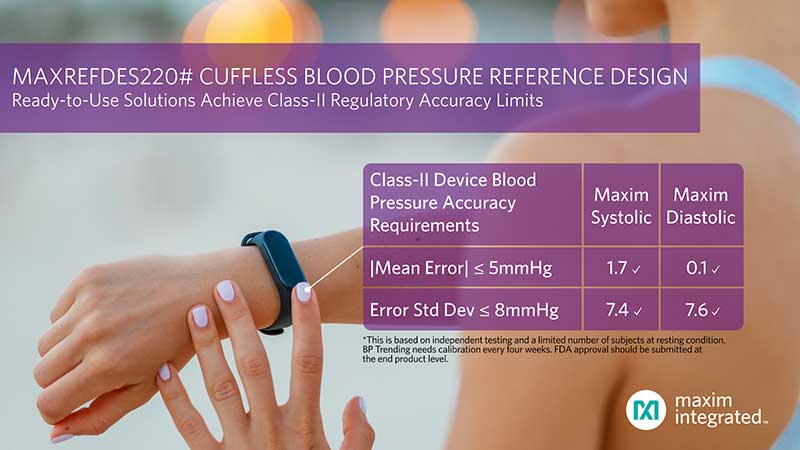
SAN JOSE, Calif.—Dec. 1, 2019—Until now, accurate blood-pressure monitoring could only be achieved with bulky and mechanical cuff-based medical devices. Now, Maxim Integrated Products, Inc. (NASDAQ: MXIM) has introduced a solid-state blood-pressure monitoring solution to more conveniently track this critical health indicator. Design engineers can develop blood-pressure trending solutions with the MAXREFDES220# reference design from Maxim. Comprised of a complete integrated optical sensor module, a microcontroller sensor hub and a sensing algorithm, the MAXREFDES220# optical blood-pressure trending solution can be embedded into smartphones or wearables. It enables users to place their finger on a device for 30-45 seconds while resting to measure blood pressure anywhere and anytime. The reference design includes the MAX30101 or MAX30102 high-sensitivity optical sensor, as well as the MAX32664D sensor hub IC with built-in algorithms.
The MAX30101 (using two LEDs) and MAX30102 (using three LEDs) pulse-oximeter and heart-rate optical sensor modules combine photodetectors, LEDs and analog front-end (AFE) electronics with an integrated cover glass. This integrated optical design and lenses-on-top approach enables optimal signal-to-noise ratio (SNR) for a small, lower cost and power-efficient module. It comes in a tiny 5.6mm x 3.3mm 14-pin optical package with an I2C interface to the sensor hub IC.
The MAX32664D sensor hub IC includes firmware which controls the sensor and executes the algorithms which measure cuffless blood pressure, heart rate and blood-oxygen levels. Its ultra-small size (1.6mm x 1.6mm) can easily fit into small devices to seamlessly and effortlessly connect to a device’s host microcontroller.
The MAXREFDES220# provides industry-best accuracy that meets Class-II regulatory limits. For example, under resting-only measurement conditions, the solution provides the following accuracies:
- Systolic Error: Mean = 1.7mmHg, Std Dev = 7.4mmHg
- Diastolic Error: Mean = 0.1mmHg, Std Dev = 7.6mmHg
- For reference, Class-II regulatory limits are |Mean Error| ≤ 5mmHg, and Std Dev ≤ 8mmHg
This solution requires calibration every four weeks to maintain above accuracies. This is based on independent testing and a limited number of subjects at resting condition.
Key Advantages
- Best Blood-Pressure Measurement Accuracy Without a Cuff: The ready-to-use reference solution measures trending blood pressure without a cuff and meets Class-II regulatory limits.
- Ease of Design: Highly integrated optical modules and ready-to-use algorithms in the sensor hub IC, together with complete optical system design guidance, enable customers to easily embed the finger-based blood-pressure solution into their devices.
- Faster Time to Market:Algorithm code runs on a small, ultra-low-power dedicated sensor hub microcontroller, eliminating the need to integrate new code into an existing application processor.
Commentary
- “Blood pressure is a key vital sign, but has traditionally been difficult to monitor conveniently and accurately. Maxim now provides a combination of products in a compact reference design which allows system designers to build highly accurate—and based on our patient testing, the most accurate—blood-pressure monitors that do not require cuffs,” said Kris Ardis, executive director in the Micros, Security and Software Business Unit at Maxim Integrated.